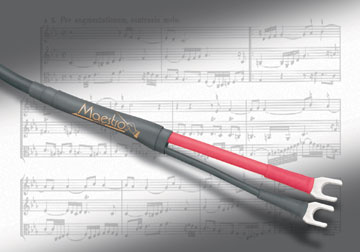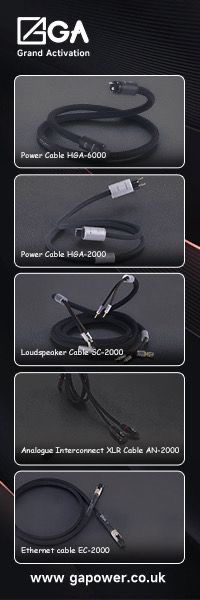Audience Maestro Audio Cables
| Audience Maestro Audio Cables |
|
|
|
Henry Wilkenson |
|
2 December 2002 |
 Specifications
Specifications
1 Meter Interconnect RCA (unbalanced): $199.00 per pair
2.5 Meter Maestro Au24 Loudspeaker Cables: $387.00 per pair
1 Meter digital Cable S/PDIF Cable: $98.00
Address:
Audience
1525 Brian Place
Escondido, California 92025
Telephone: 800-565-4390
Website: www.audience-av.com/
Audience has been receiving a good deal of praise for their Au24 line of audio cable and power cords. In my opinion, all of those accolades are well deserved. Last year, I had the opportunity to review the Au24 line up and was quite impressed. So I was eager to give a listen to the Maestro interconnects to see how they compared to the more expensive Au24s. The Maestro line is positioned between the Au24s and the least expensive Conductor series. Since it has been quite a while since I last auditioned the Au24s, I had to rely on my notes in order to make the comparison.
The Maestro interconnects and speaker wires share some of the design characteristics with the Au24s line. All Audience cable is designed for low eddy current resistance. According to product literature, this is the most important quality in producing high-resolution cables. The Maestro cables are larger than the Au24s, at 8mm in diameter. Still they are smaller and easier to handle than many competing models. The insulation is cross-linked polyethylene and the outer jacket is made of soft PVC. They are as easy to install as the Au24s since the Maestro interconnects utilize the same RCA connectors and the speaker wire uses the same spade lugs.
I recall the sound of the Au24s to be smooth and unobtrusive. That is, no one frequency was favored over another. They also demonstrated good extension at the frequency extremes without introducing any hardness to the sound. Lateral image specificity and depth was right up there with the best that I have heard, in my system, as well as others. So, the question to be answered is: can you get most of the sonic benefits of the Au24 cables for less than half the price? Well, not really. It rarely works that way in high-end audio.
The Sound
An audiophile stand-by of mine is the Patricia Barber CD, Companion[Blue Note/Premonition 7243 5 22963 2 3]. The cut “Use Me” begins with a strong bass intro that will reveal a system’s low-end capabilities. Granted, this is not bottom octave stuff, but it does require the ability to resolve textures to get it right. With the Maestro cables in the system, the fundamentals of the upright bass were delivered, but with less of the bloom that I noted with the Au24s. The midrange was very close, with a little less of the low-level detail that I know is in the recording. While Ms. Barber’s voice had the proper amount of weight, it also lacked some of the detail and intimacy that I heard with the Au24s. This is an extremely close mic’ed recording that can be somewhat in your face. Fortunately this aspect of the recording was not exaggerated. While the perspective was still forward, it wasn’t objectionable.
Genesis, by George Duke, [Illusions Warner Bros., 9 45755-2] is a heavily synthesized dance piece that makes serious demands of your system. A heavy bass line simultaneously accompanies midrange and high frequency information. Here the Maestros provided a full sound with a good sense of harmonic richness. However, some of the low-level detail was missing as well as some resolution. The Au24s were able to resolve more of the different sonic layers that are present on this disk, and to a much greater degree. If I hadn’t heard this piece through the Au24s, I might not have noticed this loss.
Miles Davis’ Kind of Blue [Columbia Legacy Ck 64935], another timeless standby of mine, fared quite well here. While the slight lack of low level detail was noticeable, it was not so great as to prevent me from enjoying the music. These cables consistently were able to get the timbres correct. There was nothing lean or threadbare about the sound, a characteristic they share with the 24s. Although the overall tonal balance was in keeping with the sonic signature of my system overall, I preferred the balance of the 24s.
With small jazz groups such as Cannonball Adderley’s, as recorded on the CD Something Else [Blue Note 1595], some of the sax solos took on a slightly hard edge. Though not something that I would characterize as a major flaw, it was present nonetheless. That said, the tonal resolution that I remember from the Au24s was evident with the Maestros as well, but to a lesser degree.
For a change of pace, I gave a listen to Aaron Copland’s Third Symphony [Reference Recording RR-93CD]. This is a symphony orchestra performing in an appropriately large space. With the Maestros, I was able to hear all of the cues that indicated the size of the hall very convincingly. The full size and weight of the orchestra was portrayed very well. Some components will focus on one sonic characteristic or another above all others. For many, that would be imaging. When I encounter any component that displays a super holographic soundstage, to me, that is somewhat off putting. This type of imaging conflicts with what I hear at live events. At live events, I fond the imaging to be anything but sharply focused. For this reason, I prefer a more moderate soundstage image with my system. The Maestros soundstage imaging was very natural to my ears. From left to right the imaging was very good and there was a reasonable sense of depth. None of the sections of the orchestra were etched or presented in what can be a spectacular but unnatural way. Overall, I found this piece to be quite enjoyable with these cables.
Sonically, everything that I listened to through the Maestros was very pleasing. As with the 24s, no one sonic characteristic stood out over everything else. I would best describe the Maestros as being tonally balanced and natural sounding.
If you have been fortunate enough to have heard and would like to own the wonderful Au24 cables and interconnects, but find that they are outside your budget, the Maestros are a very good compromise. While they are clearly not the equals of the 24s, they are in no way just filler for the product line. I would estimate that they offer at least 85% of the sonic performance of the 24s. Given there exceptional performance to price ratio, I feel that these cables offer very good value for a very reasonable price.
![]()
Don’t forget to bookmark us! (CTRL-SHFT-D)
Stereo Times Masthead
Publisher/Founder
Clement Perry
Editor
Dave Thomas
Senior Editors
Frank Alles, Mike Girardi, Russell Lichter, Terry London, Moreno Mitchell, Paul Szabady, Bill Wells, Mike Wright, and Stephen Yan,
Current Contributors
David Abramson, Tim Barrall, Dave Allison, Ron Cook, Lewis Dardick, John Hoffman, Dan Secula, Don Shaulis, Greg Simmons, Eric Teh, Greg Voth, Richard Willie, Ed Van Winkle, Rob Dockery, Richard Doron, and Daveed Turek
Site Management Clement Perry
Ad Designer: Martin Perry





Be the first to comment on: Audience Maestro Audio Cables